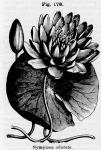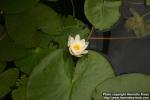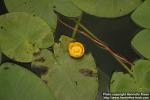Nymphaea.—Water Lily.
 The rhizome of Nymphaea odorata (Dryander), Aiton (Castalia odorata, Dryander).
The rhizome of Nymphaea odorata (Dryander), Aiton (Castalia odorata, Dryander).
Nat. Ord.—Nymphaeaceae.
COMMON NAMES: Water lily, Pond-lily, White pond-lily, Sweet-scented water lily, Water nymph, Water cabbage.
Botanical Source.—White pond-lily has a blackish, large, fleshy, perennial rhizome, growing in mud, where the water is from 3 to 10 feet in depth. It is often as thick as a man's arm, sending up leaves and flowers to the surface. The petioles are long, somewhat semi-circular, perforated throughout by long tubes or air-vessels which serve to float them. The leaves are floating, orbicular, sometimes almost kidney-shaped, peltate, cordate-cleft at the base quite to the insertion of the petiole, lobes on each side prolonged into an acute point, entire, reddish, with prominent veins beneath, dark shining-green above, 5 or 6 inches in diameter. The flowers are large, white or rose-colored, beautiful, and fragrant. Sepals 4, lanceolate, green without, white within. Petals numerous, lanceolate, 1 to 2 ½ inches long, of the most delicate texture, white, sometimes tinged with purple on the outside. Stamens numerous and yellow, in several rows; filaments dilated gradually from the inner to the outer series so as to pass insensibly into petals. Anthers in 2 longitudinal cells growing to the filaments, and opening inwardly. Stigma with 12 to 24 rays, very much resembling abortive anthers, at first incurved, afterward spreading. The pericarp is berry-like, many-celled, and many-seeded (L.—W.—G.).
History and Chemical Composition.—This plant grows in ponds, marshes, and sluggish streams, in most parts of the United States, flowering from June to September; the flowers shut at night and open about sunrise, and the seeds ripen under water. It is one of the most beautiful of flowers, and commands a ready sale among flower-lovers. The root is the medicinal part, and becomes light, spongy, and friable on drying. It has an astringent and mucilaginous, bitter taste, and readily imparts its virtues to water. The root should be collected in the fall, freed from dirt, cut into slices and carefully dried. Nymphaea is said to contain tannic and gallic acids, with starch, mucilage, resin, sugar, tartaric acid, etc. It probably contains several non-toxic alkaloids (see Related Species).
Action, Medical Uses, and Dosage.—The root is astringent, demulcent, anodyne, and antiscrofulous. Used in dysentery, diarrhoea, gonorrhoea, leucorrhoea, and scrofula, and combined with wild cherry in bronchial affections. Externally, the leaves and roots have been used in form of poultice to boils, tumors, scrofulous ulcers, and inflamed skin. In infusion, used as a gargle in ulcers of mouth and throat, and as an injection in leucorrhoea. I recollect a lady, who, several years since, was pronounced by several physicians to have uterine cancer, which resisted all their treatment; she was permanently cured by a squaw, who gave her to drink freely of the decoction of a root, which proved to be that of the white pond-lily, as well as to inject it in the vagina (J. King). It should be especially experimented with for its alterative effects and its influence on mucous tissues. A tincture may be prepared from the root (℥viii), and alcohol, 76 per cent (Oj), the dose of which ranges from 1 to 10 drops. The dose of the powdered root is ½ drachm in milk or sweetened water; but one of its best forms of administration is the infusion made by macerating for 30 minutes 1 ounce of the coarsely powdered root in a pint of boiling water, of which from 2 to 4 fluid ounces may be given 3 or 4 times a day.
Related Species.—Nuphar advena (R. Brown), Aiton (Nymphaea advena, Solander). The Yellow pond-lily, called also Spatterdock, Frog-lily, Cow-lily, etc., possesses similar properties, and may be used as a substitute for the preceding. It has a large and extensively creeping rhizome, with large, erect leaves, or floating on half-cylindrical petioles, oval, rounded at apex, with rounded, diverging lobes at base, dark shining green above, and when floating, pale and slimy beneath. Flowers rather large, globular, erect, yellow, on a thick rigid stalk. Sepals 6, the 3 outer yellow inside, the 3 inner entirely yellow. Petals numerous, small, yellow, furrowed externally, inserted with the stamens on the torus. Stamens numerous, truncated, linear. Stigma sessile, discoid, with prominent rays. Fruit an ovoid, naked pericarp, many-celled, many-seeded. It is a very common plant in ponds, ditches, muddy lakes, and mostly in shallow water (W.—G.).
 Nymphaea alba, Linné, European water lily.—The flowers of this species are official in the French Codex as Nénuphar blanc. Dragendorff (1879), and W. Grüning (Archiv der Pharm., 1882, p. 604) found in the rhizome an amorphous alkaloid probably closely related to, but not identical with, nupharin. The rhizome, according to Grüning, also contains several tannic principles, viz., ether-soluble tanno-nymphaein (C56H52O36), nymphaeo-phlobaphene (C56H48O36), and nymphaea-tannic acid proper (C56H58O38). (See Amer. Jour. Pharm., 1883, p. 96.) This drug was formerly employed as an aphrodisiac.
Nymphaea alba, Linné, European water lily.—The flowers of this species are official in the French Codex as Nénuphar blanc. Dragendorff (1879), and W. Grüning (Archiv der Pharm., 1882, p. 604) found in the rhizome an amorphous alkaloid probably closely related to, but not identical with, nupharin. The rhizome, according to Grüning, also contains several tannic principles, viz., ether-soluble tanno-nymphaein (C56H52O36), nymphaeo-phlobaphene (C56H48O36), and nymphaea-tannic acid proper (C56H58O38). (See Amer. Jour. Pharm., 1883, p. 96.) This drug was formerly employed as an aphrodisiac.
 Nuphar luteum, of Smith, contains a non-toxic alkaloid, nupharine, a white, amorphous body, soluble in alcohol, ether, chloroform, acetone, amylic alcohol, and diluted acids. The seeds contain a tannin, nuphar-tannic acid (C56H36O37), associated with nuphar-phlobaphene (C56H50O35) (Grüning, Amer. Jour. Pharm., 1883, p. 96). This agent has been employed in spermatorrhoea, and to arrest nocturnal emissions, as well as to give tone and increased power to the sexual organs. Its best effects are probably obtained in digestive disorders with morning diarrhoea, and in chronic diarrhoea. Dr. Zell Baldwin praises the fluid extract of Nuphar luteum, employed full strength locally, as a valuable agent in many chronic forms of uterine disease (Ec. Annual of Med. and Surg.). The dose, of a strong tincture of the fresh root, is a fraction of a drop every 3 or 4 hours.
Nuphar luteum, of Smith, contains a non-toxic alkaloid, nupharine, a white, amorphous body, soluble in alcohol, ether, chloroform, acetone, amylic alcohol, and diluted acids. The seeds contain a tannin, nuphar-tannic acid (C56H36O37), associated with nuphar-phlobaphene (C56H50O35) (Grüning, Amer. Jour. Pharm., 1883, p. 96). This agent has been employed in spermatorrhoea, and to arrest nocturnal emissions, as well as to give tone and increased power to the sexual organs. Its best effects are probably obtained in digestive disorders with morning diarrhoea, and in chronic diarrhoea. Dr. Zell Baldwin praises the fluid extract of Nuphar luteum, employed full strength locally, as a valuable agent in many chronic forms of uterine disease (Ec. Annual of Med. and Surg.). The dose, of a strong tincture of the fresh root, is a fraction of a drop every 3 or 4 hours.

